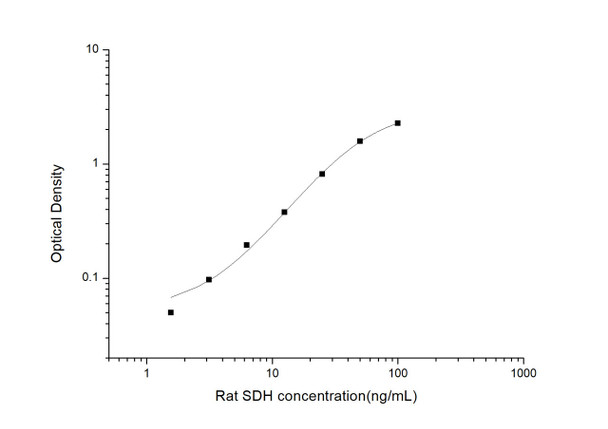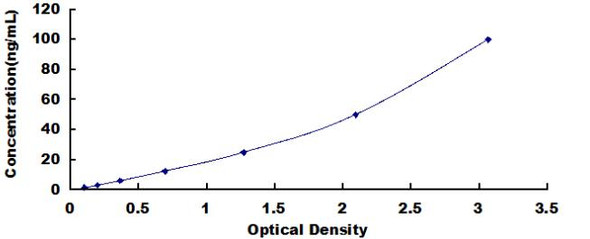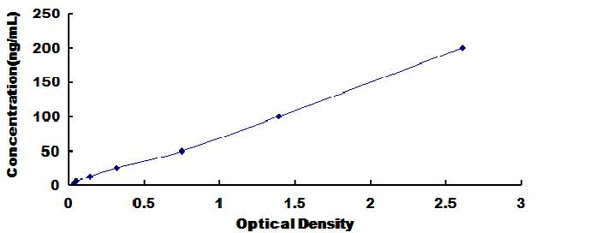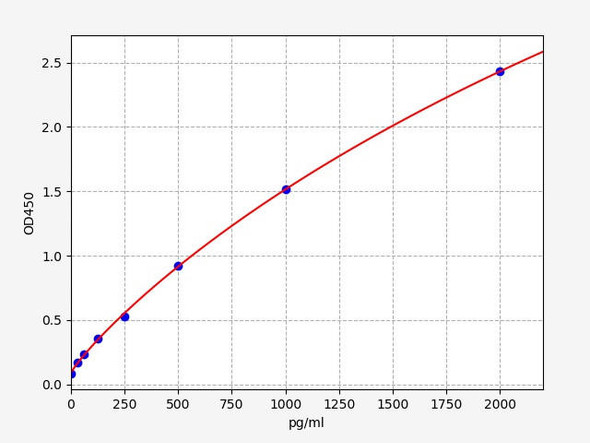Description
Rat SDH (Sorbitol Dehydrogenase) ELISA Kit
The Rat SDH (Sorbitol Dehydrogenase) ELISA Kit is specifically designed for the precise quantification of SDH levels in rat serum, plasma, and tissue homogenates. This kit is known for its exceptional sensitivity and specificity, providing accurate and consistent results for various research purposes.Sorbitol Dehydrogenase is an enzyme that plays a crucial role in the metabolism of sorbitol, a sugar alcohol.
Abnormal levels of SDH have been associated with various metabolic disorders, making it a valuable biomarker for studying these conditions and developing potential therapies. The Rat SDH ELISA Kit offers a reliable tool for researchers to investigate the role of SDH in metabolic pathways and diseases.
| Assay type: | Sandwich |
| Format: | 96T |
| Assay time: | 4.5h |
| Reactivity: | Rat |
| Detection Method: | Colormetric |
| Detection Range: | 1.56-100 ng/mL |
| Sensitivity: | 0.94 ng/mL |
| Sample Volume Required Per Well: | 100µL |
| Sample Type: | Serum, plasma and other biological fluids |
| Specificity: | This kit recognizes Rat SDH in samples. No significant cross-reactivity or interference between Rat SDH and analogues was observed. |
This ELISA kit uses Sandwich-ELISA as the method. The micro ELISA plate provided in this kit has been pre-coated with an antibody specific to Rat SDH. Standards or samples are added to the appropriate micro ELISA plate wells and combined with the specific antibody. Then a biotinylated detection antibody specific for Rat SDH and Avidin-Horseradish Peroxidase (HRP) conjugate are added to each micro plate well successively and incubated. Free components are washed away. The substrate solution is added to each well. Only those wells that contain Rat SDH, biotinylated detection antibody and Avidin-HRP conjugate will appear blue in color. The enzyme-substrate reaction is terminated by adding Stop Solution and the color turns yellow. The optical density (OD) is measured spectrophotometrically at a wavelength of 450 nm ± 2 nm. The OD value is proportional to the concentration of Rat SDH. The concentration of Rat SDH in samples can be calculated by comparing the OD of the samples to the standard curve.
| UniProt Protein Function: | SORD: Converts sorbitol to fructose. Part of the polyol pathway that plays an important role in sperm physiology. May play a role in the sperm motility by providing an energetic source for sperm. Belongs to the zinc-containing alcohol dehydrogenase family. |
| UniProt Protein Details: | Protein type:Carbohydrate Metabolism - fructose and mannose; EC 1. 1. 1. 14; Oxidoreductase Chromosomal Location of Human Ortholog: 3q35 Cellular Component: membrane; mitochondrial membrane; mitochondrion Molecular Function:D-xylulose reductase activity; identical protein binding; L-iditol 2-dehydrogenase activity; NAD binding; zinc ion binding Biological Process: fructose biosynthetic process; L-xylitol catabolic process; L-xylitol metabolic process; response to cadmium ion; response to copper ion; response to drug; response to hormone; response to nutrient levels; response to osmotic stress; sorbitol catabolic process; sorbitol metabolic process; sperm motility |
| NCBI Summary: | catalyzes the conversion of L-iditol and NAD+ to L-sorbose and NADH in the polyol pathway; acts as a tetramer with one zinc atom per subunit [RGD, Feb 2006] |
| UniProt Code: | P27867 |
| NCBI GenInfo Identifier: | 77404286 |
| NCBI Gene ID: | 24788 |
| NCBI Accession: | NP_058748. 2 |
| UniProt Secondary Accession: | P27867,Q4FZY4, Q5I0F3, A2VCV9, |
| UniProt Related Accession: | P27867 |
| Molecular Weight: | 38,235 Da |
| NCBI Full Name: | sorbitol dehydrogenase |
| NCBI Synonym Full Names: | sorbitol dehydrogenase |
| NCBI Official Symbol: | Sord |
| NCBI Protein Information: | sorbitol dehydrogenase |
| UniProt Protein Name: | Sorbitol dehydrogenase |
| UniProt Synonym Protein Names: | L-iditol 2-dehydrogenase |
| Protein Family: | Serine 3-dehydrogenase |
| UniProt Gene Name: | Sord |
As the OD values of the standard curve may vary according to the conditions of the actual assay performance (e. g. operator, pipetting technique, washing technique or temperature effects), the operator should establish a standard curve for each test. Typical standard curve and data is provided below for reference only.
| Concentration (ng/mL) | O.D | Average | Corrected |
| 100 | 2.326 2.364 | 2.345 | 2.264 |
| 50 | 1.639 1.673 | 1.656 | 1.575 |
| 25 | 0.914 0.882 | 0.898 | 0.817 |
| 12.5 | 0.44 0.478 | 0.459 | 0.378 |
| 6.25 | 0.279 0.273 | 0.276 | 0.195 |
| 3.13 | 0.184 0.172 | 0.178 | 0.097 |
| 1.56 | 0.129 0.133 | 0.131 | 0.05 |
| 0 | 0.079 0.083 | 0.081 | -- |
Precision
Intra-assay Precision (Precision within an assay): 3 samples with low, mid range and high level Rat SDH were tested 20 times on one plate, respectively.
Inter-assay Precision (Precision between assays): 3 samples with low, mid range and high level Rat SDH were tested on 3 different plates, 20 replicates in each plate.
| Intra-assay Precision | Inter-assay Precision | |||||
| Sample | 1 | 2 | 3 | 1 | 2 | 3 |
| n | 20 | 20 | 20 | 20 | 20 | 20 |
| Mean (ng/mL) | 5.51 | 14.16 | 43.96 | 5.69 | 14.21 | 43.75 |
| Standard deviation | 0.30 | 0.58 | 1.93 | 0.29 | 0.79 | 1.72 |
| C V (%) | 5.44 | 4.10 | 4.39 | 5.10 | 5.56 | 3.93 |
Recovery
The recovery of Rat SDH spiked at three different levels in samples throughout the range of the assay was evaluated in various matrices.
| Sample Type | Range (%) | Average Recovery (%) |
| Serum (n=5) | 89-101 | 95 |
| EDTA plasma (n=5) | 91-105 | 98 |
| Cell culture media (n=5) | 89-105 | 96 |
Linearity
Samples were spiked with high concentrations of Rat SDH and diluted with Reference Standard & Sample Diluent to produce samples with values within the range of the assay.
| Serum (n=5) | EDTA plasma (n=5) | Cell culture media (n=5) | ||
| 1:2 | Range (%) | 89-99 | 97-112 | 93-110 |
| Average (%) | 94 | 104 | 101 | |
| 1:4 | Range (%) | 86-100 | 84-97 | 85-96 |
| Average (%) | 92 | 90 | 90 | |
| 1:8 | Range (%) | 92-106 | 83-97 | 82-96 |
| Average (%) | 97 | 90 | 89 | |
| 1:16 | Range (%) | 90-105 | 84-95 | 88-100 |
| Average (%) | 96 | 89 | 93 |
An unopened kit can be stored at 4°C for 1 month. If the kit is not used within 1 month, store the items separately according to the following conditions once the kit is received.
| Item | Specifications | Storage |
| Micro ELISA Plate(Dismountable) | 8 wells ×12 strips | -20°C, 6 months |
| Reference Standard | 2 vials | |
| Concentrated Biotinylated Detection Ab (100×) | 1 vial, 120 µL | |
| Concentrated HRP Conjugate (100×) | 1 vial, 120 µL | -20°C(shading light), 6 months |
| Reference Standard & Sample Diluent | 1 vial, 20 mL | 4°C, 6 months |
| Biotinylated Detection Ab Diluent | 1 vial, 14 mL | |
| HRP Conjugate Diluent | 1 vial, 14 mL | |
| Concentrated Wash Buffer (25×) | 1 vial, 30 mL | |
| Substrate Reagent | 1 vial, 10 mL | 4°C(shading light) |
| Stop Solution | 1 vial, 10 mL | 4°C |
| Plate Sealer | 5 pieces | |
| Product Description | 1 copy | |
| Certificate of Analysis | 1 copy |
- Set standard, test sample and control (zero) wells on the pre-coated plate and record theirpositions. It is recommended to measure each standard and sample in duplicate. Note: addall solutions to the bottom of the plate wells while avoiding contact with the well walls. Ensuresolutions do not foam when adding to the wells.
- Aliquot 100µl of standard solutions into the standard wells.
- Add 100µl of Sample / Standard dilution buffer into the control (zero) well.
- Add 100µl of properly diluted sample (serum, plasma, tissue homogenates and otherbiological fluids) into test sample wells.
- Cover the plate with the sealer provided in the kit and incubate for 90 min at 37°C.
- Aspirate the liquid from each well, do not wash. Immediately add 100µL of BiotinylatedDetection Ab working solution to each well. Cover the plate with a plate seal and gently mix. Incubate for 1 hour at 37°C.
- Aspirate or decant the solution from the plate and add 350µL of wash buffer to each welland incubate for 1-2 minutes at room temperature. Aspirate the solution from each well andclap the plate on absorbent filter paper to dry. Repeat this process 3 times. Note: a microplatewasher can be used in this step and other wash steps.
- Add 100µL of HRP Conjugate working solution to each well. Cover with a plate seal andincubate for 30 min at 37°C.
- Aspirate or decant the solution from each well. Repeat the wash process for five times asconducted in step 7.
- Add 90µL of Substrate Reagent to each well. Cover with a new plate seal and incubate forapproximately 15 min at 37°C. Protect the plate from light. Note: the reaction time can beshortened or extended according to the actual color change, but not by more than 30min.
- Add 50 µL of Stop Solution to each well. Note: Adding the stop solution should be done inthe same order as the substrate solution.
- Determine the optical density (OD value) of each well immediately with a microplate readerset at 450 nm.










